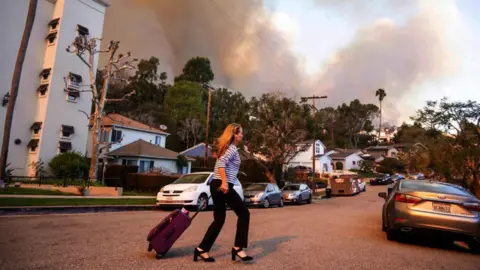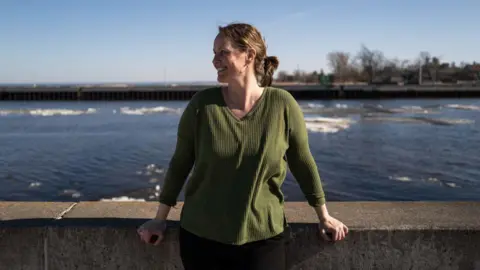Physical Address
304 North Cardinal St.
Dorchester Center, MA 02124
Physical Address
304 North Cardinal St.
Dorchester Center, MA 02124

 Getty Images
Getty ImagesChristina Welch still remembers what the sky looked like the day a wildfire came within 2 miles (3.2 km) of her home in Santa Rosa, California.
It was the Tubbs Fire of 2017, the most destructive in California history at the time. Ms. Welch’s neighbor woke her up in the morning and told her to get her things and get out. When Ms. Welch opened the door, ash was falling from the sky and smoke filled the air.
Then, in 2019, a wildfire in Kincaid forced her parents to evacuate for five days.
It was the final push for Ms. Welch. Following her friend’s advice, she packed up and drove across the country to her new hometown: Duluth, Minnesota.
“It was just the culmination of it all,” the 42-year-old said. “There are only so many times that I was going to go through every fall worrying that I was going to burn down when I was going to lose the house.”
Ms. Welch is one of several people who have fled California in recent years because of climate disasters, even before the deadliest wildfires in Los Angeles’ history killed 25 people this month.
Just this week, a new fast-moving wildfire broke out in Los Angeles County, northwest of the city, forcing tens of thousands of people to evacuate an already devastated region. Last week, Trump said he would soon visit Southern California to see the devastation from the fires.
Climate experts say they haven’t seen mass migration out of the state due to climate change so far — and it’s hard to estimate the number of people who have left for that reason. However, the state’s population growth rate has continued to decline since 2000, according to the U.S. Census.
But scientists and demographics experts say that as climate disasters become more extreme and unpredictable, the number of people leaving the state could increase, leaving some unprepared cities struggling to accommodate new residents.
“There might be this wave of new people saying, ‘You know what? California just isn’t going to work for me because this is the third time in five years that I’ve had to close my doors because of heavy soot and smoke,” said University of Michigan data science professor Derek Van Berkel.
“We have to start preparing for these kinds of surprises because they will become more frequent and more extreme.”
 Getty Images
Getty ImagesA number of climate-related factors could force Californians to leave their homes over the next decade. From 2020 to 2023, wildfires destroyed more than 15,000 buildings in California, according to CalFire. At least 12,000 buildings were lost in the Los Angeles wildfires that broke out earlier this year.
The state also faces other impacts of climate change, including flooding. According to the state attorney general’s office, half a million Californians could be at risk of flooding by 2100.
According to the California Department of Conservation, the state also experiences at least two earthquakes a year of magnitude 5.5 or greater.
As climate disasters become more extreme and frequent, home insurance rates in the state also continue to rise. More than 100,000 Californians have lost their home insurance since 2019, according to a San Francisco Chronicle analysis.
The data suggests that climate migration is so far more of a local phenomenon, with some moving inland or even seeking higher ground in their city to avoid flooding, said Jeremy Porter, head of climate impacts at First Street, which conducts climate modeling risk
But in recent years, he said, fewer people have started flocking to cities outside California that tout themselves as potential “climate havens.”
The term comes from climate adaptation researcher Jesse Keenan, who in 2019 created a list of places expected to be least affected by climate change.
At the top of the list is Duluth, Minnesota, a former industrial city of about 90,000 whose population has been growing slowly since 2020 after years of stagnation.
One of the city’s strengths is its proximity to the Great Lakes, a series of lakes that comprise the largest body of fresh water in the world. Approximately 10% of the US and 30% of Canada rely on lakes for drinking water.
“In a scenario where resources have become scarce, this is a huge value,” Mr Van Berkel said.
The water supply of the Great Lakes drew Jamie Beck Alexander and her family to Duluth. Alarmed by three consecutive seasons of devastating wildfires in California, Ms. Alexandra, her husband, and two young children piled into a van and drove across the country to Minnesota in 2020.
Ms. Alexandra found similarities between the small progressive town and their old town of San Francisco.
“There’s a real depth of connection between people and deep rootedness, things that I think are important for climate resilience,” she said.
Ms. Welch ignored her friends, who thought she was crazy, to move to a city known for its record snowfall and ice, averaging 106 sub-zero days a year. The bright, beautiful city on the hill became her own, she said.
“There are a lot of people here who love where they live and want to protect it,” Ms. Welch said of Duluth.
While some cities have designated themselves as climate havens, smaller local governments remain challenged to find the resources to plan for new residents and climate resilience, Mr. Van Berkel said.
Mr. Van Berkel works with Duluth and other cities in the Great Lakes region on climate change planning, including welcoming new residents who are relocating due to climate change.
The city of Duluth declined to respond to the BBC’s request for comment on how it is preparing to potentially host climate migrants.
At the moment, Mr. Porter said, the Great Lakes region and other “climate haven” cities are not seeing high levels of migration. But if that changed, many wouldn’t be ready, he said.
“There is a huge investment required in local communities … for those communities to be able to accommodate the kind of population that some of the climate migration literature suggests,” Mr Porter said.
In the city of Duluth, for example, housing availability can be a problem, Ms. Alexandra said. She said that while the city has room for new housing, it currently does not have enough new development for its growing population. As a result, she said, housing prices have risen in the years since she moved.
And any new housing and other development must also be done with climate change in mind, Mr Van Berkel said.
“We don’t want to make mistakes that could be very costly to our infrastructure when climate change rears its ugly head,” he said.
In 2024, a Category 4 hurricane destroyed more than 2,000 homes and businesses in Kelsey Lahr Climate Harbor in Asheville, North Carolina.
She moved there in 2020, drawn to the city’s warm climate, restaurants and music after a series of devastating wildfire and mudslide seasons near her hometown of Santa Barbara, California.
Before moving, Ms. Lahr carefully researched the most climate-resilient places to live, with Asheville leading the way because of its milder temperatures and inland location that protects it from flooding.
But Hurricane Helen swept through western North Carolina last year, killing more than 100 people in the state and destroying Ms. Lahr’s new hometown of Asheville. Many were left without electricity for almost 20 days and without drinking water for more than a month.
“Clearly, the southern Appalachians are not the ‘climate haven’ they’ve been made out to be,” Ms. Lahr said.
 Kelsey Lahr
Kelsey LahrIn Deluta, Ms. Alexandra said her family also learned quickly that they cannot escape climate change.
In their first summer, the city was engulfed in the same smog and poor air quality that drove them out of California – this time from wildfires in Canada.
“It was such a really deep joke that the universe played on me,” she said. “If we don’t address the root cause (of climate change), we’re always going to feel like we have to pick up and move.”
She has since moved to Wisconsin for personal reasons, but says she has no regrets about making her first trip to Minnesota. Ms. Lahr also has no regrets about moving to Asheville.
Although Ms. Lahr often misses the ancient forests of California’s Yosemite National Park, where she spent summers as a park ranger, a future that could bring new climate disasters requires sacrifice, she said.
“I think more and more that climate paradises are a myth,” she said. “Everyone has to assess the risk where they live and go from there.”